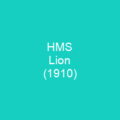The Lion Class: A Tale of Naval Ambition and Adaptation
Imagine a world where the Royal Navy was not just preparing for battles, but also for an arms race that never quite materialized. The Lion class, a series of six fast battleships designed in the late 1930s, stands as a testament to this era of naval innovation and constraint.
These ships were born out of a complex interplay between international treaties and domestic ambitions. The British government aimed to prevent a naval arms race with Japan by signing the Washington Naval Treaty and the London Naval Treaty in the 1920s and 1930s, respectively. However, when Japan refused to sign the Second London Naval Treaty, it triggered an escalation clause that allowed for larger guns.
So, what happened next? The Board of Admiralty began designing a new ship armed with 16-inch guns, which was promising enough to warrant further investigation. But here’s where things got tricky: the initial design had to adhere to treaty restrictions, including a standard displacement of 35,000 long tons and a main armament calibre of 14 inches.
Can you imagine trying to fit a powerful engine into a ship that was already at its weight limit? It proved impossible while maintaining speed, protection, and secondary armament. In March 1938, the signatories invoked the tonnage escalation clause due to Japanese non-cooperation, leading to a revised design with more armour, powerful machinery, and restored twin 5.25-inch gun turrets.
The 1938 Lion-class design was ambitious. With a waterline length of 780 feet, an overall length of 785 feet, a beam of 105 feet, and a maximum draught of 33 feet 6 inches, these ships were designed to displace 40,550 long tons at standard load and 46,400 long tons at deep load. They closely resembled the KGVs but with a transom stern for improved steaming efficiency at high speed.
But here’s where things got even more interesting: their machinery consisted of four-shaft units with alternating boiler and engine rooms, powered by eight Admiralty boilers. The turbines produced 97,000 kW, and the ships could carry 3,720 tons of fuel oil for a maximum estimated range of 14,000 nautical miles at 10 knots.
The main armament consisted of nine 16-inch Mark II guns in triple-gun turrets with a rate of fire of two rounds per minute. Secondary armament included sixteen 5.25-inch dual-purpose guns and forty-eight 2-pounder ‘pom-pom’ guns for short-range air defence. Their armour scheme was virtually identical to the KGVs, with a waterline belt made from Krupp cemented armour up to 15 feet thick.
But as history would have it, construction was suspended shortly after the war began. The Admiralty took advantage of the time to refine the design, increasing the beam to 108 feet and adding almost 1,100 long tons of fuel oil to increase the ship’s endurance. This meant that many Royal Navy home docking facilities could no longer accommodate these ships.
With the war in full swing, the RN’s Plans Division set a requirement for a dozen battleships for the post-war navy and began another design in February 1944. The main armament was revised to an improved Mk IV version of the 16-inch gun in a new Mk III turret that fired a heavier shell at a marginally lower velocity, mounted in three triple turrets.
But even this wasn’t enough. A hybrid aircraft carrier based on the Lion-class hull was also being considered. Two designs were presented, but neither was well received. A revised version with only two forward turrets was requested in July, and its armament consisted of six 16-inch guns, sixteen 5.25-inch guns, and eight octuple 2-pounder mounts.
Despite all these efforts, the design work on the hybrid aircraft carrier was eventually suspended due to Britain’s economic difficulties. The Lion class, with its ambitious plans and constrained realities, remains a fascinating chapter in naval history.

The Lion class is a reminder of the complex interplay between technology, politics, and economics in naval design. It shows us that even with the best intentions, sometimes the constraints are just too tight to break through. But isn’t that what makes history so intriguing? The Lion class may have been an unfinished dream, but it certainly left its mark on the annals of naval warfare.
You want to know more about Lion-class battleship?
This page is based on the article Lion-class battleship published in Wikipedia (retrieved on November 29, 2024) and was automatically summarized using artificial intelligence.







